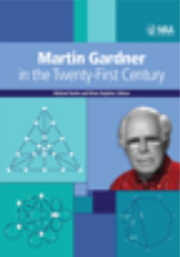Book contents
- Frontmatter
- Preface
- Contents
- I Geometry
- II Number Theory and Graph Theory
- III Flexagons and Catalan Numbers
- IV Making Things Fit
- V Further Puzzles and Games
- VI Cards and Probability
- 30 Modeling Mathematics with Playing Cards
- 31 The Probability an Amazing Card Trick Is Dull
- 32 The Monty Hall Problem, Reconsidered
- 33 The Secretary Problem from the Applicant's Point of View
- 34 Lake Wobegon Dice
- 35 Martin Gardner's Mistake
- VII Other Aspects of Martin Gardner
- Index
- About the Editors
30 - Modeling Mathematics with Playing Cards
from VI - Cards and Probability
- Frontmatter
- Preface
- Contents
- I Geometry
- II Number Theory and Graph Theory
- III Flexagons and Catalan Numbers
- IV Making Things Fit
- V Further Puzzles and Games
- VI Cards and Probability
- 30 Modeling Mathematics with Playing Cards
- 31 The Probability an Amazing Card Trick Is Dull
- 32 The Monty Hall Problem, Reconsidered
- 33 The Secretary Problem from the Applicant's Point of View
- 34 Lake Wobegon Dice
- 35 Martin Gardner's Mistake
- VII Other Aspects of Martin Gardner
- Index
- About the Editors
Summary
Because playing cards have values 1 through 13 (jacks 11, queens 12, kings 13), come in two colors, four suits, and have fronts and backs, they provide wonderfully convenient models for hundreds of unusual mathematical problems involving number theory and combinatorics. What follows is a choice selection of little known examples.
One of the most surprising of card theorems is known as the Gilbreath principle after magician Norman Gilbreath who first discovered it. Arrange a deck so the colors alternate. Cut it so the bottom cards of each half are different colors, and then riffle shuffle the halves together. Take cards from the top in pairs. Amazingly, every pair will consist of a red and black card!
Here is a simple proof by induction that this must happen. Assume that the first card to fail on the table during the shuffle is black. If the next card to fail is the card directly above it in the same half, that card will be red. This places on the table a red-black pair. If the next card after the first one comes from the other half, it too will be red and will put a red-black pair on the table. In either case, after two cards have dropped, the bottom cards of each half will be of different colors, so the situation is exactly the same as before, and the same argument applied for the rest of the cards.
- Type
- Chapter
- Information
- Martin Gardner in the Twenty-First Century , pp. 221 - 226Publisher: Mathematical Association of AmericaPrint publication year: 2012



